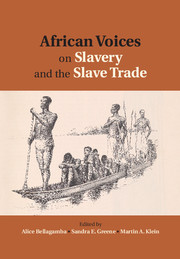61 results
Index
-
- Book:
- African Voices on Slavery and the Slave Trade
- Published online:
- 05 March 2016
- Print publication:
- 14 April 2016, pp 198-206
-
- Chapter
- Export citation
2 - Christian missionaries on record
-
-
- Book:
- African Voices on Slavery and the Slave Trade
- Published online:
- 05 March 2016
- Print publication:
- 14 April 2016, pp 50-73
-
- Chapter
- Export citation
Copyright page
-
- Book:
- African Voices on Slavery and the Slave Trade
- Published online:
- 05 March 2016
- Print publication:
- 14 April 2016, pp iv-iv
-
- Chapter
- Export citation
Acknowledgements
-
- Book:
- African Voices on Slavery and the Slave Trade
- Published online:
- 05 March 2016
- Print publication:
- 14 April 2016, pp ix-x
-
- Chapter
- Export citation
4 - African intellectual ideas in the age of legal slavery and the slave trade
-
-
- Book:
- African Voices on Slavery and the Slave Trade
- Published online:
- 05 March 2016
- Print publication:
- 14 April 2016, pp 93-113
-
- Chapter
- Export citation
Contents
-
- Book:
- African Voices on Slavery and the Slave Trade
- Published online:
- 05 March 2016
- Print publication:
- 14 April 2016, pp v-v
-
- Chapter
- Export citation
Contributors
-
- Book:
- African Voices on Slavery and the Slave Trade
- Published online:
- 05 March 2016
- Print publication:
- 14 April 2016, pp vii-viii
-
- Chapter
- Export citation
Figures
-
- Book:
- African Voices on Slavery and the Slave Trade
- Published online:
- 05 March 2016
- Print publication:
- 14 April 2016, pp vi-vi
-
- Chapter
- Export citation
Introduction - Sources and methods
-
-
- Book:
- African Voices on Slavery and the Slave Trade
- Published online:
- 05 March 2016
- Print publication:
- 14 April 2016, pp 1-14
-
- Chapter
- Export citation

African Voices on Slavery and the Slave Trade
-
- Published online:
- 05 March 2016
- Print publication:
- 14 April 2016
Severe Influenza in 33 US Hospitals, 2013–2014: Complications and Risk Factors for Death in 507 Patients
-
- Journal:
- Infection Control & Hospital Epidemiology / Volume 36 / Issue 11 / November 2015
- Published online by Cambridge University Press:
- 30 July 2015, pp. 1251-1260
- Print publication:
- November 2015
-
- Article
- Export citation
Contributors
-
-
- Book:
- Clinical Gynecology
- Published online:
- 05 April 2015
- Print publication:
- 23 April 2015, pp viii-xiv
-
- Chapter
- Export citation
Lisa Lindsay and John Wood Sweet, eds. Biography and the Black Atlantic. Philadelphia: University of Pennsylvania Press, 2014. xiv + 370 pp. Map. Notes. Bibliography. List of Contributors. Index. $55.00. Cloth.
-
- Journal:
- African Studies Review / Volume 58 / Issue 1 / April 2015
- Published online by Cambridge University Press:
- 16 March 2015, pp. 259-261
-
- Article
- Export citation
Strategies to Prevent Surgical Site Infections in Acute Care Hospitals: 2014 Update
- Part of
-
- Journal:
- Infection Control & Hospital Epidemiology / Volume 35 / Issue S2 / September 2014
- Published online by Cambridge University Press:
- 10 May 2016, pp. S66-S88
- Print publication:
- September 2014
-
- Article
-
- You have access
- Export citation
Strategies to Prevent Surgical Site Infections in Acute Care Hospitals: 2014 Update
-
- Journal:
- Infection Control & Hospital Epidemiology / Volume 35 / Issue 6 / 01 June 2014
- Published online by Cambridge University Press:
- 10 May 2016, pp. 605-627
- Print publication:
- 01 June 2014
-
- Article
- Export citation
History - Robin Law. Ouidah: The Social History of a West African Slaving “Port,” 1727–1892. Athens: Ohio University Press/Oxford: James Currey, 2004. vii + 308 pp. Maps. Tables. Bibliography. Index. $49.95. Cloth. $29.95. Paper.
-
- Journal:
- African Studies Review / Volume 49 / Issue 2 / September 2006
- Published online by Cambridge University Press:
- 23 May 2014, pp. 210-211
-
- Article
- Export citation
Symbols and Social Activism: An Agenda for African Studies and the ASA for the 21st Century
-
- Journal:
- African Studies Review / Volume 42 / Issue 2 / September 1999
- Published online by Cambridge University Press:
- 23 May 2014, pp. 1-14
-
- Article
- Export citation
Robin Law. Ouidah: The Social History of a West African Slaving “Port,” 1727–1892. Athens: Ohio University Press/Oxford: James Currey, 2004. vii + 308 pp. Maps. Tables. Bibliography. Index. $49.95. Cloth. $29.95. Paper.
-
- Journal:
- African Studies Review / Volume 49 / Issue 3 / December 2006
- Published online by Cambridge University Press:
- 23 May 2014, pp. 96-97
-
- Article
- Export citation

